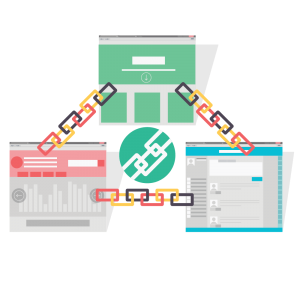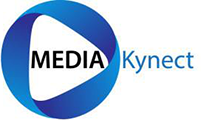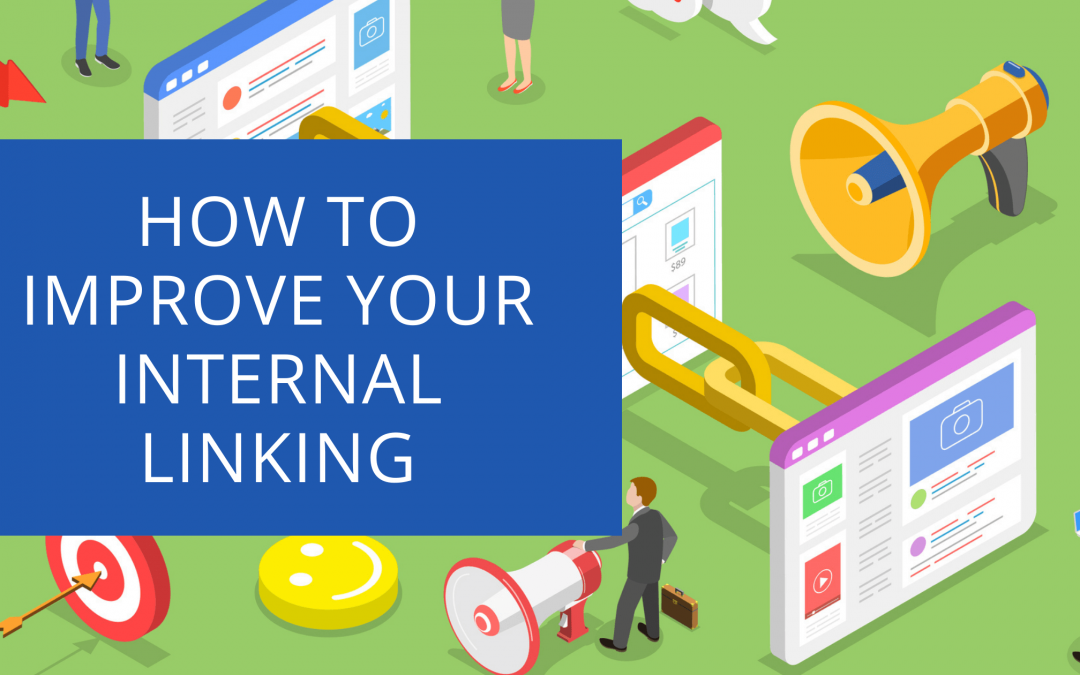Internal linking is a necessary piece of SEO that can be overlooked by many business owners. Internal links are important because they help search engines index your website more efficiently, helps users navigate through your site more easily, and allow the relevancy and authority signals to flow throughout your website.
Contents
What are internal links?
Internal links are hyperlinks that point to resources within the same website. For example, you have a blog post about cooking with cast iron cookware. You mention in your article that you also wrote an interesting piece on how to season cast iron cookware. In this instance, it would be helpful to link the phrase “how to season cast iron cookware” to the specific blog post.
 Internal linking helps search engines index your website more efficiently, which is a huge part of SEO. Search engines can’t crawl all over every single page on your site without being able to find links throughout it. By using internal links that point between pages and posts on your site, you’re helping search engines crawl your site more efficiently.
Internal linking helps search engines index your website more efficiently, which is a huge part of SEO. Search engines can’t crawl all over every single page on your site without being able to find links throughout it. By using internal links that point between pages and posts on your site, you’re helping search engines crawl your site more efficiently.
Internal linking helps users navigate through your site more easily, which is important for user experience. If visitors are unable to find their way on a website they will most likely leave or bounce off of the page after just a few seconds. Internal links help keep visitors engaged with content on your website by allowing them to easily navigate through your posts and pages.
Internal linking allows the relevancy and authority signals to flow throughout your website. When you link to a page or post on your site, it helps strengthen its relevancy because you are indicating that this is a helpful piece of content for users looking at other parts of your site.
Navigational links are links in your top menu or in your sidebars that guide visitors to other pages, or they might be footer navigation links.
Contextual links
Landing pages and blog posts are the two most common platforms for contextual links. They lead to relevant and intriguing material that complements what you’re talking about. Google understands what the page is about because of them, which is why an excellent internal linking structure is crucial.
Types of Anchor Text
The different types of anchor text include the following:
- Exact match: Anchor text that precisely matches the page’s targeted keyword you want to rank for is known as exclusive match anchor text. For example, using “anchor text” as the link’s anchor text.
- Partial match: When internal linking, you can use partial match anchor text by combining your targeted keyword with other keywords. Using “understanding link text” as an anchor text when optimising for “anchor text.”
- Phrase match: The term “anchor text” is often used to describe the practice of employing a phrase as a keyword in other similar-sounding phrases. For example, “guide to optimising anchor text for SEO.”
- Branded: Anchor text that includes the name of your business is branded. For example, “Media Kynect.”
- Naked: The URL with no text is the naked anchor text. For example, “mediakynect.co.uk” as the anchor text is an example of this.
- Generic: The main purpose of anchor text is to direct visitors to a page or another post on your site. “Click here” or “learn more,” for example, are examples of anchor text.
- Images: Image anchor text is also similar to a CTA. Here, you will use an anchor on an image.
What is the difference between Internal Links and External Links?
The difference between internal links and external links is that Internal links are links from one page on your website to another page on your website. External Links are links from your website to a different website.
Internal Linking Best Practises
Link To Relevant Content
![]() An internal linking SEO tactic is to link out from the phrase “how to season cast iron cookware” to a specific cooking blog post about seasoning your cast iron pan. This helps search engines index our website properly for the related keyword “cast iron cookware.”
An internal linking SEO tactic is to link out from the phrase “how to season cast iron cookware” to a specific cooking blog post about seasoning your cast iron pan. This helps search engines index our website properly for the related keyword “cast iron cookware.”
Use Descriptive Anchor Text
Whenever possible, you should create descriptive links for SEO. If the page that is linking to another page on your site has a relevant phrase in it — “how-to season cast iron cookware,” for example — use anchor text with similar keywords to help search engines understand what the content is about.
Create supporting content to boost rankings for your money pages
By creating quality blog posts that are closely related to your money pages, you can help boost their SEO rankings. This is because the search engines will see your site as being more authoritative on the topic when they index all of your content together.
Send “link juice” from powerful pages to other pages
The more powerful pages you have on your website, the more “link juice” they will pass along to other pages. This helps boost the SEO rankings of those other pages because they are receiving links from a high-authority source.
Internal Linking FAQ
What is anchor text?
The text in a hyperlink on a web page is called anchor text and is clickable and will take you to another web page.
What are internal links?
Internal links are links from one page on your site to another location on the same website. They help search engines discover what pages you have and how they’re related, which helps them index your website for specific keywords more effectively than if there were no internal links.
What is the difference between an external link and an internal link?
An external link, also known as a hyperlink, goes from your site to another website or vice versa. An example of this would be if you linked text on one page and linked it directly to another post or page on someone else’s website. Internal links, meanwhile, are the hypertext that goes from one page to another on your site.
How do I create an internal link?
To create internal links, use the HTML code “<a href=” to place a link inside of your text.
e.g. <a href=”https://mediakynect.co.uk”>Media Kynect</a>
If you use a content management system with a WYSIWYG (What you see is what you get) editor, links can be created by highlighting text and choosing to create a link.
What is an inbound link?
An inbound link is a hyperlink that points to your website from another website.
What is link juice?
 Link juice is a term used in SEO to describe the authority that a page has on a website. The more powerful or relevant pages there are on your site, the more link juice they have and will pass along to other pages which helps their rankings increase.
Link juice is a term used in SEO to describe the authority that a page has on a website. The more powerful or relevant pages there are on your site, the more link juice they have and will pass along to other pages which helps their rankings increase.
What is a money page?
A money page is an important piece of content on your site that you want to rank for specific keywords and get conversions. It would also be a page that contains high-quality, unique information and/or products that are relevant to the topic at hand.
What is a WYSIWYG?
WYSIWYG is an acronym for “What you see is what you get.” It’s a term used in web development to describe a system in which the user sees the content of a webpage as it will be published, without having to worry about the underlying code.
We Offer SEO Services Nationwide
- Chester:https://mediakynect.co.uk/seo-chester/
- Wirral: https://mediakynect.co.uk/seo-wirral/
- Liverpool: https://mediakynect.co.uk/seo-liverpool/
- North Wales: https://mediakynect.co.uk/seo-north-wales/
- Wrexham: https://mediakynect.co.uk/seo-wrexham/
Conclusion
Internal linking is an important part of SEO and can help boost your website’s rankings for specific keywords. By using descriptive anchor text, creating quality blog posts related to your money pages, and passing along link juice from powerful pages on your site, you can improve your internal linking strategy and see better results in the search engines.
If you have any questions about internal linking or would like some help getting started, don’t hesitate to reach out! We’re happy to help.

